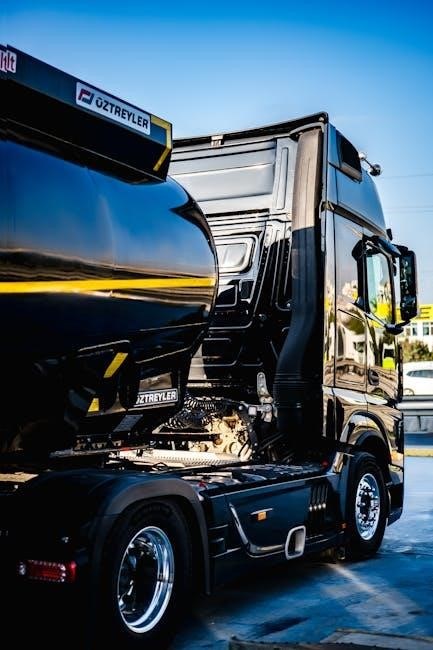affecting their performance and driver experience greatly always considered carefully online.
Overview of Transmission Types
Transmission types for semi trucks include manual, automatic, and automated manual transmissions, each with unique characteristics and advantages, and are used in various driving situations, with some transmissions better suited for certain tasks, such as hauling heavy loads or driving in mountainous terrain, and transmission types can be divided into subcategories, such as splitter, range, and range splitter for manual transmissions, and each type has its own set of features and benefits, including ease of use, fuel efficiency, and control, and understanding the different transmission types is essential for drivers and fleet owners to make informed decisions when purchasing or operating semi trucks, and the choice of transmission type can significantly impact the overall performance and safety of the vehicle, and the internet provides a wealth of information on transmission types and their applications, with many online resources available to help drivers and owners learn more about the different types of transmissions and their uses.

Manual Transmission in Semi Trucks
Manual transmissions are traditional options for semi trucks, offering control and efficiency, with
- various features
and benefits for drivers and fleet owners to consider in their operations always online.
Characteristics of Manual Transmissions
Manual transmissions in semi trucks have distinct characteristics, including a range of gear options, splitter and range splitter types, and a need for driver engagement. The transmissions require a level of driver expertise, with a clutch pedal and gearshift used to change gears. This type of transmission is well-suited to certain driving conditions, such as mountainous terrain, where driver control is essential. In these situations, manual transmissions can provide better performance and fuel efficiency. Additionally, manual transmissions can be more cost-effective to maintain and repair, with fewer complex components compared to automatic transmissions. Overall, the characteristics of manual transmissions make them a popular choice for certain types of driving and fleet operations, with many drivers preferring the control and flexibility they offer. With proper training and experience, drivers can effectively operate manual transmissions, maximizing their benefits and minimizing their drawbacks.
Automatic Transmissions in Semi Trucks
Automatic transmissions in semi trucks offer convenience and ease, with
- technological advancements
improving their performance and efficiency always considered online daily.
Advantages of Automatic Transmissions
Automatic transmissions in semi trucks have several advantages, including ease of use and reduced driver fatigue, with
- technological advancements
improving their performance and efficiency.
The use of automatic transmissions can also improve safety, as drivers are able to focus more on the road and less on shifting gears.
Additionally, automatic transmissions can provide better fuel efficiency, especially in heavy traffic or hilly terrain, where manual transmissions may struggle.
Overall, the advantages of automatic transmissions make them a popular choice for many semi truck drivers and fleets, and their use is likely to continue to grow in the future, with
- key benefits
such as increased productivity and reduced maintenance costs, making them a valuable option for the trucking industry.
Automatic transmissions are also becoming more prevalent in newer semi truck models, and are expected to play a major role in the future of the trucking industry, with many manufacturers investing in their development and implementation.

Evaluation of Transmission Types
Evaluation involves comparing
- transmission types
to determine the best option for semi trucks, considering factors like performance and driver experience always.
Key Aspects of Transmission Evaluation
Key aspects of transmission evaluation include several factors that affect the overall performance of semi trucks, with a focus on driver recruitment, safety and control, fuel savings, and overall driving experience, as mentioned in various online sources.
The evaluation process involves comparing different transmission types, including manual and automatic, to determine the best option for specific driving conditions and requirements.
Transmission evaluation is crucial in the trucking industry, as it can impact the efficiency and productivity of semi trucks, as well as the safety of drivers and other road users.
By considering these key aspects, truck manufacturers and owners can make informed decisions about the type of transmission to use in their vehicles, and drivers can operate their trucks with confidence and efficiency, using the information provided on the internet to guide their decisions and choices.
Transmission evaluation is an ongoing process, with new technologies and innovations continuously being developed and introduced to the market, aiming to improve the performance and efficiency of semi trucks.

Percentage of Automatic Semi Trucks
Approximately 50 percent of semi trucks are automatic, according to recent estimates and
- industry reports
online sources indicate a significant increase.
Prevalence of Automatic Transmissions
The prevalence of automatic transmissions in semi trucks has increased significantly over the years, with many manufacturers now offering automatic options as standard or optional equipment. According to industry reports, around 50 percent of new semi trucks sold today come equipped with automatic transmissions. This shift towards automatic transmissions can be attributed to the ease of use and reduced driver fatigue they offer. Additionally, automatic transmissions are often preferred by fleets and trucking companies due to their ease of maintenance and reduced risk of driver error. The use of automatic transmissions is also more prevalent in certain regions and industries, such as in urban areas where traffic is heavier and drivers need to navigate through congested roads. Overall, the prevalence of automatic transmissions in semi trucks is a growing trend that is expected to continue in the coming years, with more manufacturers investing in automatic transmission technology and more fleets adopting automatic-equipped trucks.

Future of Manual Transmissions in Semi Trucks
The future of manual transmissions in semi trucks is uncertain, with many experts predicting a decline in their use. The rise of automatic transmissions has led to a decrease in the demand for manual transmissions, and many manufacturers are phasing out manual options in their newer models. However, some trucking companies and drivers still prefer manual transmissions for their better control and fuel efficiency in certain driving conditions. The used semi truck market will likely continue to feature manual transmissions, but their availability may decrease over time. As technology continues to advance, it is likely that manual transmissions will become less common in semi trucks, but they will not disappear completely. In fact, some manufacturers are exploring new technologies that combine the benefits of manual and automatic transmissions, which could potentially extend the life of manual transmissions in the industry.
